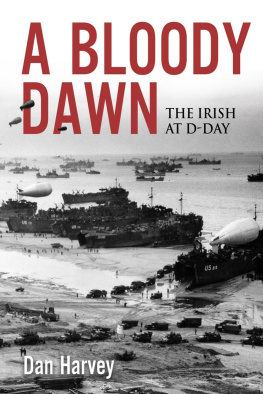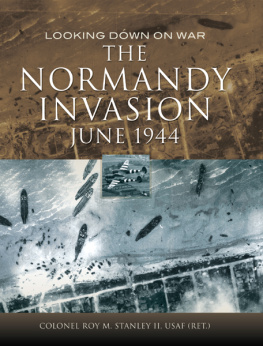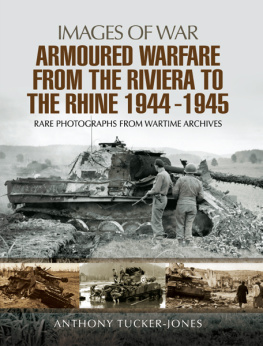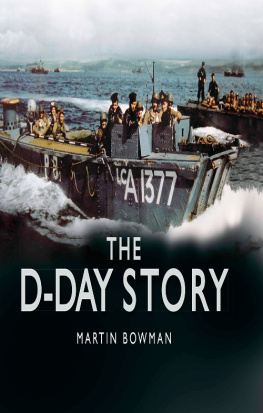THE
AMERICANS
ON D-DAY
A PHOTOGRAPHIC HISTORY OF THE NORMANDY INVASION
MARTIN K.A. MORGAN

On the front cover: In what has become one of the most famous photographs of D-Day, Chief Photographers Mate Sargent captures the men of the same assault boat team seen in the previous photograph as they wade through the surf in front of the Easy Red sector of Omaha Beach at approximately 7:30 a.m. on June 6, 1944. These E Company, 16th Infantry Regiment troops are assaulting the area between Exit E-1 and Exit E-3 under fire from Widerstandsnest 62 and Widerstandsnest 65. On the beach directly ahead of the ramp can be seen M4 Sherman tank Number 9 from A Company, 741st Tank Battalion. U.S. Coast Guard Collection in the U.S. National Archives 26-G-2343
On the frontis: A soldier from the 1st Battalion, 8th Infantry Regiment carrying an M1917A1 Heavy Machine Gun and a belt of .30-caliber ammunition passes through La Madeleine after landing on Utah Beach. The house behind him served as the command post for Oberleutnant Matz, the German officer from 3, Grenadier Regiment 919, who commanded Widerstandsnest 5. This machine gunner still wears his lifebelt and assault gas mask bag. Attached to his M1936 Pistol Belt is an M1911A1 .45-caliber Pistol in its holster and an M1910 entrenching tool. National Archives and Records Administration/US Army Signal Corps 111-SC-190466
First published in 2014 by Zenith Press, a member of Quayside Publishing Group Inc., 400 First Avenue North, Suite 400, Minneapolis, MN 55401 USA
2014 Zenith Press
Text 2014 Martin K. A. Morgan
All rights reserved. With the exception of quoting brief passages for the purposes of review, no part of this publication may be reproduced without prior written permission from the Publisher.
The information in this book is true and complete to the best of our knowledge. All recommendations are made without any guarantee on the part of the author or Publisher, who also disclaims any liability incurred in connection with the use of this data or specific details.
We recognize, further, that some words, model names, and designations mentioned herein are the property of the trademark holder. We use them for identification purposes only. This is not an official publication.
Zenith Press titles are also available at discounts in bulk quantity for industrial or sales-promotional use. For details write to Special Sales Manager at Quayside Publishing Group, 400 First Avenue North, Suite 400, Minneapolis, MN 55401 USA.
To find out more about our books, visit us online at www.zenithpress.com
Digital edition: 978-1-62788-154-8
Hardcover edition: 978-0-76034-620-4
Library of Congress Cataloging-in-Publication Data
Morgan, Martin K. A.
The Americans on D-Day : a photographic history of the normandy invasion / by Martin K. A. Morgan.
pages cm
Includes bibliographical references and index.
ISBN 978-0-7603-4620-4 (hbk. : alk. paper)
1. World War, 1939-1945--Campaigns--France--Normandy--Pictorial works. 2. United States--Armed Forces--Pictorial works. 3. Soldiers--United States--Pictorial works. I. Title.
D761.M595 2014
940.5421421--dc23
2013047061
Editor: Elizabeth Demers
Design Manager: James Kegley
Layout Designer: Becky Pagel
CONTENTS
To the memory of
Joe Wilson Morgan, III
March 5, 1963February 21, 2010
Introduction
THE PHOTOGRAPHIC RECORD is priceless. As the Normandy invasion grows more distant in the mirror of history, the pictures remain with us, almost an uncompromising keepsake to that extraordinary, remarkable event. The pictures illustrate what we read in the original documents or the veterans memoirs, or the words we hear as we listen to their personal stories. The photos provide us with definition and context. They humanize what is now a legendary event. Each photograph conveys only a single moment in time, a second of experience, a glimpse into the reality of that instant. They cannot and do not tell us all, but they do tell us something honest. The photographs show us the uniforms, the weapons, the equipment, the hairstyles, the food, the setting, even the time of day on that momentous June 6, 1944. More interesting, the best of them convey the mood and the emotions of the participants. They show the fear, the anticipation, the confusion, and, in some instances, the camaraderie of a particular moment.
The photographs of the Normandy invasionmany of them familiar to most anyone who has studied D-Dayhave created unforgettable images in our minds and, for many of us, they have inspired myriad questions. Where was this photo taken? Who are the soldiers in the image? What was their mission at the time? What happened to them? Did they notice the photographer taking their picture? How did they feel about that? Martin K. A. Morgan has spent years gathering and studying the images. He has walked the hallowed invasion beaches countless times. He has dug deeply into archives in multiple countries, poring over image after image. Over the years, he has befriended large numbers of veterans, many of whom have been kind enough to trust him with their own pictures. Suffice it to say his expertise on the photographic record of the Normandy invasion is formidable and impressive. Thus, Martins captions provide quite a few answers to our age-old questions. As you leaf through this handsome book, you will undoubtedly see numerous familiar photographs and you might be tempted to think you know the story behind them and their proper context. With all due respect, you would most likely be wrong in that assumption. Martin has taken those familiar images and made them new again because of his truly remarkable level of knowledge and insight. He has also succeeded in presenting many new or previously little-known photographs among the pages that follow. So, sit back and enjoy a fresh look at one of historys most significant events, as seen through the keen eyes of the talented photographers of yesteryear and a fine historian of our own time.
John C. McManus
St. Louis, MO
Author of The Americans at D-Day and The Dead and Those about to Die: D-Day, June 6, 1944, the Big Red One at Omaha Beach
Authors Introduction
THE D-DAY INVASION OF NORMANDY in 1944 remains one of the most famous combat operations of World War II. In seven decades, countless histories have examined various aspects of this pivotal battle, from broad focus to close detail. While the sheer number of titles available seems to suggest that everything the world needs to know about D-Day has already been written, the reality is quite the opposite. Mythology and hyperbole swirl around the subject, producing historical distortions that continue to interfere with a balanced and nuanced understanding of June 6. For example, despite what countless bad television programs will tell you, D-Day was not the largest invasion in history. For that matter, it was not even the largest amphibious landing operation of World War II. That record belongs to the Operation Iceberg landings on Okinawa in 1945. Although not the biggest, the airborne component of June 6, 1944, definitely made it the most complicated invasion of World War II. But in a modern cultural environment where every subject seems to have a hyperbolized narrative, the Normandy invasion is no exception.








